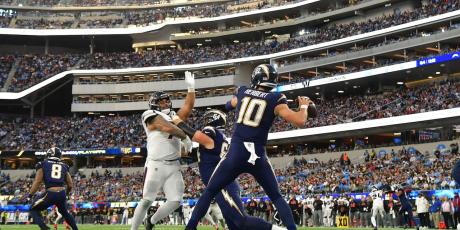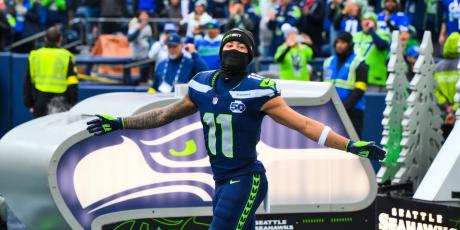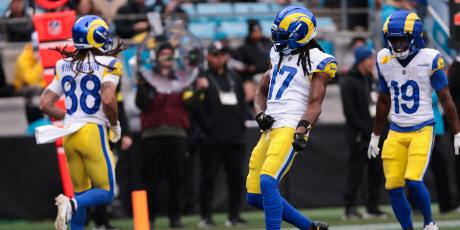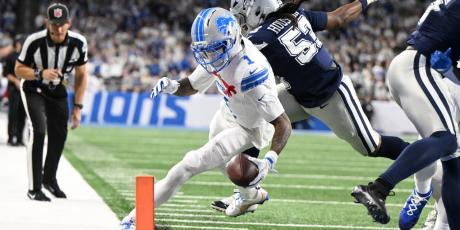IDP Draft Strategy: The Definitive Guide

Unsure of the rules, settings, and strategies in an IDP league?
The following guide will provide the basic scoring formats, positional requirements, and league rules you need to know to get started.
It will also provide draft strategy tips for each position, as well as some more advanced strategies.
IDP a new way to follow and enjoy, not only fantasy, but football in general, so if you’ve decided to join an IDP league, buckle up! It’s a fun ride and one you’ll want to continue riding year after year.
Editor's Note: Click here for 2018 IDP draft strategy edition.
More 2017 Positional Draft Strategies: QB | WR | Zero RB | TE | Streaming D/ST | PR & KR
2 Must-Knows for Getting Started with IDP
To prep for an IDP draft, you need to be aware of a couple of key elements of your league: scoring format and positional requirements.
1. Scoring Format
Big-play, tackle-heavy and balanced (a mix of big-play and tackle-heavy) are the three main IDP scoring formats.
Big-Play Format
Big-play scoring typically refers to formats that devalue tackles and place more of an emphasis on the splash plays, which are far less predictable. Below is a common example of big-play scoring:
-
Sacks: 6 points
- Fumble Recoveries: 4 points
- Interceptions: 4 points
- Tackles for Loss: 2 points
-
Forced Fumbles: 2 points
- Passes Defended: 2 points
-
Solo tackles: 1 point
Tackles are more frequent, so they aren’t valued as highly as sacks or splash plays, which places a higher value on a sack specialist like Von Miller or Justin Houston, while at the time same placing less emphasis on a tackle machine like Bobby Wagner. There are elite players who thrive in most formats, like Luke Kuechly or J.J. Watt, who should be high IDP selections no matter the format.
Tackle-Heavy Format
In a tackle-heavy format, tackles are emphasized with doulble the points per solo tackle relative to big-play formats Below is a common example of tackle-heavy scoring:
-
Interceptions: 4 points
-
Solo tackles: 2 points
- Sacks: 2 points per half sack
-
Fumble Recoveries: 2 points
-
Forced Fumbles: 2 points
-
Assisted Tackles: 1 point
-
Passes Defended: 1 point
Drafting a tackle machine like Luke Kuechly, who has averaged nearly 93 solo tackles in his first four years, can help you rack up double-digit IDP points each week by racking up tackles alone. This format puts less of an emphasis on pass rushers, who tend to rely on sacks for fantasy scoring while failing to rack up many tackles. Pass rushers can go multiple games without a sack, increasing the chances of them producing few IDP points in a given week.
Note: Another scoring intricacy to consider is return yardage, as this puts a little more value into a corner or safety, since they can sometimes be primary kick returners.
Related: 2017 IDP Ranking Breakdown
2. Positional Requirements
Before drafting, you need to know three things about your specific league's rules:
- How many defensive players you have to start each week
- How many you can roster
- If there are limitations as to how many you can draft at each position
For example, you may be limited to drafting just five linebackers. What are your position designations? Do you have to draft DT and DE? Or is it a general DL position? Those rules and requirements matter.
If this is your first IDP league, I suggest using just one at each position, which means 36 IDPs at a minimum will be drafted.
If you want to get more advanced, I suggest starting 2 DL, 2-3 LB and 2-3 DB along with the offensive starters.
4for4's Top-100 IDP Rankings will give you a good idea of who we value at each IDP position and should help you find great value at each position.
2 Keys to IDP Pre-Draft Prep
In preparation for an IDP draft, all you need to know is how a defensive player's role and his positional designation will affect his draft value.
1. Know The Defensive Scheme
What defensive scheme a defender plays in is an important component of IDP leagues. A defender can be a supreme talent, but may not score much because of his role in the scheme. By the same token, a below-average player can fill up the stat sheet because of opportunity presented by his scheme.
Does the defensive player play on every down?
If a defender is going to be on the field for 80 percent or more of his team's snaps, that gives him more opportunity to make plays and score fantasy points.
Linebackers who are in their team’s sub packages (i.e., nickel and dime pass defenses) are going to be more valuable than linebackers who are only strong against the run and thus confined to only playing in the base defense. If a defender has scored just three or four points in a few weeks, but suddenly balloons to 10-15 points per week, chances are, the player has increased his snap counts and has earned a role outside of the base defense.
Does the defensive player play in a 4-3 or 3-4 scheme?
Nowadays, a lot of the defenses are playing more hybrid schemes and sub packages, which has varying degrees of impact based on scoring format.
If you’re deciding between a linebacker in a tackle-heavy format, a 4-3 middle linebacker is going to score higher and provide more value than a 3-4 outside linebacker because the 4-3 middle linebacker's tackle opportunities are going to be more frequent than that of the 3-4 outside linebacker. Likewise, in a big-play scoring format, a 3-4 pass rusher like Von Miller will be of more value than a 4-3 middle 'backer like Anthony Hitchens. Below are some general hierarchies for deciding between players in different schemes:
- 4-3 MLB > 4-3 SAM
- 4-3 WLB > 4-3 SAM
- 3-4 ILB > 4-3 SAM
- 3-4 ILB > 3-4 OLB
- 4-3 DE > 3-4 DE
- Safety > Cornerback
These aren’t steadfast rules, so refer to your league’s scoring. Also keep in mind that defensive schemes can change. A shift from a 3-4 to a 4-3 base, or vice-versa, is going to have an impact on a defender's opportunities and chances at tackles or sacks. For example, a 4-3 defensive tackle is going to see less tackle opportunities if he's moved to the nose tackle position in a 3-4. Why? He's eating more blockers and space so that edge rushers can instead make plays on the quarterback. Same goes for 3-4 defensive ends -- their value tends to dip in those schemes because they are clearing out space for the outside 'backers to pass rush.
Teams that went from 3-4 to 4-3 base in 2017: Bills, Browns, Chargers, Eagles, 49ers
Teams that went from 4-3 to 3-4 base in 2017: Rams
2. Keep an Eye on Positional Designations
Has a linebacker been moved to the defensive line? Has a linemen been moved to outside linebacker? Has a safety shifted to linebacker? Positional movement will have an impact on a defender’s IDP value.
For instance, if a player with a DE designation were to get moved to linebacker, specifically OLB, he would lose value because he would be entering a deep pool of potential options. On the other hand, if an edge rushing OLB were to get moved end and receive a DL designation, his IDP value would get a boost.
One of this season's targets will be Melvin Ingram, who will go from LB to DE.
Basic IDP Draft Strategy in 4 Steps
An IDP draft strategy revolves around what order you target each position, and which type of players you target at each position.
1. Plan to Draft Your Offensive Players First
As an IDP enthusiast, I love the defensive side of the ball. I love when a linebacker chases down a running back and gets him for a loss. I appreciate the spin moves and bull rushes of a defensive linemen that allow him to get to the quarterback. In fantasy, however, a good defense is a good offense. What does that mean?
You need to build a solid offensive squad before considering your first IDP.
This goes back to knowing your scoring system, but typically you’re going to want to grab your offensive players first. In a 20-round draft, I recommend drafting the foundation of your starting lineup and a few backups before considering your first IDP, so it may be into round nine before you first consider taking a defender. Since league rules and scoring will vary, there aren't really any sources of reliable IDP ADP, so it can be tough to pinpoint when an IDP run will start.
As much as I love Watt and Kuechly, I don’t suggest drafting them early. You're better off drafting someone like Theo Riddick, Danny Woodhead or even Quincy Enunwa ahead of Watt or Kuechly. As you will also see, linebacker is a deep position, so Kuechly isn’t a must-draft player. I can make a case for Kuechly, or even Kwon Alexander, to be the No. 1 overall IDP player selected, but the gap between those guys and the next two tiers of linebackers isn't that huge.
Again: Build your offense first, add some backups, then consider your first IDP.
2. Target Defensive Line as Your First IDP
In the past, I was an advocate of the linebacker-early-and-often approach. When you think you have enough linebackers, draft another and wait on your DL and DB positions. While I still believe in the linebacker position, I recommend looking at DL sooner than later. The NFL has shifted to more of a pass-oriented league, but defensive linemen who can amass double-digit sacks are rare, so the position is scare with elite options. Meanwhile, the linebacker position is deep with guys who have 100-tackle potential and can be weekly LB1s.
Which Type of DL to Draft
Although there are exceptions, I like to target DLs who are playing in a 4-3 base as opposed to a 3-4 base defense. As mentioned, lineman in a 3-4 are typically trying to take up space and fill gaps allowing the edge rushing outside linebackers to make plays and get to the quarterback. Nose tackles, unless you’re in a deeper league where defensive tackles are required, can be ignored.
Related: Myles Garrett & 7 Other Rookie Defensive Lineman to Target in IDP Leagues in 2017
When it comes to snaps, defensive linemen, like linebackers, need to be on the field as often as possible to make an impact. If a defensive lineman plays on over 70 percent of snaps, he’ll be on the field enough to get the requisite amount of fantasy opportunities.
Therefore, I’d advocate drafting defensive lineman like Watt, Carlos Dunlap, or Joey Bosa before drafting your first linebacker. By drafting a defensive lineman who can average nearly one sack per game, you can give yourself a major edge.
Also make sure to target linemen who can also average 3-4 tackles per game. At least 45 tackles in a season should be the floor you target.
I’d feel much more comfortable with a duo of Dunlap/Olivier Vernon, for instance, than a combo of Everson Griffen/Cliff Avril; you might be chasing points on the waiver wire with the latter pairing. It only makes sense to start targeting linebackers after you have an elite player in each DL slot - in fact, I like to have multiple elite DLs on my roster whenever possible.
In tackle-heavy formats, a defensive lineman who can produce pressure and get tackles becomes even more valuable. Here is a list of DLs who produced at least 50 tackles and 8 sacks in 2016:
- Danielle Hunter – 56 tackles/12.5 sacks
- Khalil Mack (depending on league designation) – 73 tackles/11 sacks
- Olivier Vernon – 63 tackles/8.5 sacks
- Calais Campbell – 53 tackles/8 sacks
3. Target Linebacker as Your Second IDP
As mentioned, linebackers are not as scarce as defensive lineman, but they are more valuable than defensive backs, so it's advisable to make them second priority after DL and before DB.
Which Type of LB to Draft
The 4-3 MIKE and 3-4 inside linebackers are the leaders of the defense and wear the 'green dot’, meaning they’re calling all plays and audibles. Everything funnels through them.
The 4-3 weakside linebackers can also be strong fantasy producers since they line up on the weaker side of the offense and don't have to always get around extra blockers. Some of the faster linebackers in the league man the weak side.
Related: Reuben Foster, Jarrad Davis, and 7 Other Rookie Linebackers to Target in IDP Leagues in 2017
Don't be afraid of rookie linebackers, either, especially if they are in good spots to produce. Back in 2015, for instance, Stephone Anthony was inserted into the starting lineup and notched 111 total tackles. Kwon Alexander and Eric Kendricks were also productive rookies. In 2014, CJ Mosely finished as LB6 in tackle-heavy scoring, while Chris Borland and Preston Brown also finished among the Top-30 in LB scoring. Make sure to scout rookies who find themselves atop the depth chart. If you need a quick guide, here's a link to the rookie LBs I'm targeting.
4. Wait on Defensive Back
Defensive back is even deeper than linebacker, but it’s also far more volatile and unpredictable. Over the last few seasons, Reshad Jones, Jonathan Cyprien, Charles Woodson and Eric Weddle have all made multiple appearances among the top 10 DB scorers, yet only Woodson and Weddle made it in consecutive weeks. There’s typically an elite DB every year...and then there’s the rest of the position. For instance, two seasons ago the DB4, Malcolm Jenkins, was the last DB taken in the average draft, while the DB6, Mark Barron, wasn’t even drafted. Neither was Corey Graham, who finished as the DB2.
Which Type of DB to Draft
Unless you’re in a league where cornerback is its own position, target safeties, as they are the most consistent IDP scorers.
Interceptions are sexy, but they are inconsistent and unpredictable. Patrick Peterson and Richard Sherman are outstanding football players, but are lousy for fantasy because they aren’t thrown at often.
In fact, of the top 30 fantasy DBs in in 2016, only four were cornerbacks. In 2015, only six were cornerbacks. In 2014, five were cornerbacks. Safety is the key position because they are getting the tackles on a weekly basis. In 2016, only two cornerbacks had at least 70 tackles (Logan Ryan and Vernon Hargreaves III).
If you are in a league where you are picking cornerbacks, the better the corner, the worse fantasy producer they tend to be. The top cornerbacks rarely see many balls thrown their way, thus limiting their opportunities for big plays or tackles.
In 2016, Ryan was the target for opposing passers nearly 18.9 percent of the time, which allowed him to record a position-leading 79 tackles and lead all cornerbacks in scoring. I typically like to target corners who are playing opposite an elite corner, as well as rookie corners, since the quarterback is going to throw their way more often. Look no further than 2015, when three rookie cornerbacks appeared in the top-25 in CB scoring. Marcus Peters led the way, finishing as the overall CB1. Peters was targeted over 20 percent of the time, defending 26 passes, producing eight interceptions, and notching 61 tackles.
Don't forget: Wait, wait, wait on defensive back. If you miss out on the top option, it’s okay. There will always be turnover in the ranks, enabling you to get a solid producer in the middle or end of your draft.
Advanced IDP Draft Strategy Tips
Knowing when to target each position will give you a solid foundation, but there are also a few other tips to keep in mind that will take you to the next level.
Don't Handcuff
If you draft an injury-prone linebacker like Sean Lee, it’s not really necessary to draft his backup and waste a pick. The IDP player pool is so deep that it’s just not a necessity like it would be to draft a running back's handcuff. Depending on the size of your league and how many IDPs you start, you’ll be able to acquire an IDP who has comparable value. Of course, if an elite IDP gets injured, his production will be difficult to replace -- much like an elite offensive player.
Take Advantage of the Previous Season's Injuries
If your league members are new to the IDP format, chances are they could be using last year's total fantasy points as a metric to determine who to draft. This can put you at an advantage, especially if an elite defender missed a significant portion of the previous season. While your league mates are scrolling through the top scorers, they are missing out on possible defenders who produce elite fantasy numbers when healthy.
One of those defenders I'm targeting this year is NaVorro Bowman. Bowman missed most of the 2016 season after recording 236 total solo tackles between 2013 and 2015. In his healthy seasons, Bowman has produced 140 or more total tackles.
Look at IDPs that have missed time to injury and evaluate their track record of production to identify overlooked targets.
In-Season Start/Sit Strategy for Each IDP Position
Each week you may have to make a choice about which IDP to start, Below are tips for each position:
- DL: Projecting DL on a weekly basis can be a bit tricky, but you'll typically want to start your elite guys every week. The best thing you can do is play the matchups and play a lineman facing a weaker offensive line or a rookie QB.
- LB: Linebackers are still your most consistent scorers in IDP. Start the linebackers slated to play the most defensive snaps (ideally 85-90 percent).
- DB: If you’re in a cornerback-required league, stream the position and use the waiver wire as your friend.
Photo by Robert Reiners/Getty Images.
Still not a 4for4 subscriber? Sign up here!
Related Articles






















